

Darwin Runners & Walkers Inc. has links to a Senior Athletics club which existed in Darwin in the 1960s. It was a Country Association of the South Australian Athletics Association. The name has changed a few times, but the spirit has remained the same.
In 1964/65 a club called the 'Beltanas' existed in Darwin. It later changed name to the 'Waratahs' so that runners could use the facilities at the old Waratah oval in Fannie Bay. Merv Brooks, a Darwin High School teacher, trained the group which included Peter Whelan who still runs with the club today.
The club closed, but in 1973 a few interested persons re-formed the senior Athletics Association to cater for juniors who became too old for Little Athletics, and to cater for adult athletes. Track and field was held once per week at St John's College oval.
At about the same time, a group of teachers started weekly cross-country runs from Dripstone Cliffs at Casuarina Beach in 1973. Gordon Johnstone was the driving force behind this, assisted later by Russell Willis and Klaus Roth. More than 100 runners competed regularly, the course heading inland from the cliffs, through bush towards where Brinkin and Charles Darwin University are today, across sand dunes, into swamps and through the coastal forest. A few runners from the 1970s are still with the club today.

Cross-Country in 1976 - running up the track from Rapid Creek to the Dripstone Cliffs.
It is these links with the past that provided a base for development of the current club.
The idea of Darwin's City to Surf came when Gordon Johnstone spoke to Jim Woodriffe, who knew about Sydney's event. They thought it would be a good event for Darwin, so Gordon organised the first City to Surf on 8 June 1974. It attracted 150 runners, a good percentage of whom were associated with Casuarina High School. Here are the results of the 1974 City to Surf as reported in the NT News.

The start of the first City to Surf at Old Darwin Oval on the Esplanade, 8 June 1974.
The arrival of Cyclone Tracy on Christmas Eve in 1974 put a temporary stop to track and field, and to cross-country, but activities quickly resumed in 1975. The cyclone destroyed parts of the old cross-country course so the start was moved from the cliffs to near where Dripstone Park is now situated. The new course went across the dunes, through the coastal forest, across a creek - waist deep at times - and out to a relatively clear area near Rocklands Drive before heading back through the bush to the finish.
With the growing popularity of athletics and fun running in the mid 1970s, a group called the 'Northern Territory Amateur Athletic Centre' (NTAAC) formed. The year began with a cross-country season, followed by track and field in the dry season and cross-country again towards the end of the year. Regular road running began in the 1976 dry season.
The organisational skills of Klaus Roth and Russell Willis were invaluable to the development of the club. The numbers of runners increased from 80-100 in 1978 to 300 in 1981. By 1981, the name 'Darwin Athletic Club' was being used. It evolved from the NTAAC and conducted track and field, road running and cross-country events. Apart from those already mentioned, persons instrumental in development of the club at this time, and who had a long association with it, were Dave and Mary Reader, Brian Gleeson, Bernie Trinne, Pat Sedman, Neil Halligan and Bill Smith.
From 1981, track and field took place at a permanent venue at Malak Oval, while cross-country was run from Dripstone Park in the wet season, and road running from the Rapid Creek Water Gardens in the dry season. Cross-country and road running were always held on Thursdays. The 5-km road run followed Freshwater Road, Rothdale Road, McMillans Road, Rapid Creek Road and back to the Water Gardens. In May 1984, regular road runs were held from Malak Oval, the course including paths in Malak Park and roads around the area.
The first out-of-town cross-country was a morning run at Fred's Pass Reserve in Darwin's rural area Sunday 19 February 1984. Despite a very heavy downpour just before dawn, there was a good turnout with 69 participants. From November 1986, there was a move away from Dripstone Park as a fixed venue for cross-country runs in the town area. Runs were held at Holmes Jungle, East Point, Marlow Lagoon (Palmerston), as well as at Dripstone Park. The Fred's Pass cross-country developed into an annual weekend event from 1989.
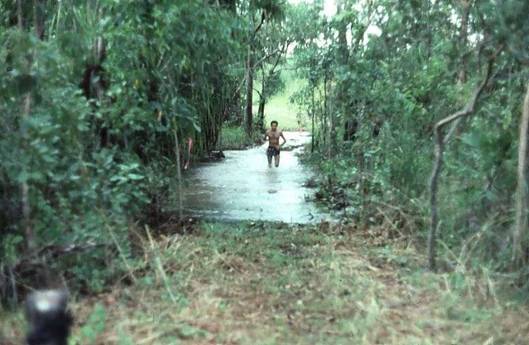
Murray Wood leading the Fred's Pass Cross-Country on 9 March 1991.
The first handicap series was held in 1985. Handicap events have become very popular in recent years, the task of determining handicaps being a very delicate task.
In 1986 a printed program was produced for the first time in a format resembling the current format. From January 1987, road running was held in the wet season, starting from the car park at Vestey's Beach. This marked the beginning of the current practice of rotating cross-country and road runs at different venues throughout the year.
In 1987/88, some of the older members in the Darwin Athletic Club formed a Darwin Veteran Athletic Club, but it failed to persist as a separate entity.
Track and Field became independent of the Darwin Athletic Club in 1990. This allowed the club to concentrate on road running and cross-country, and 1990 is the year when the name changed to 'Darwin Runners Club'. Subsequently, in January 1991, the committee changed the regular weekly run from Thursday to Wednesday at 6pm. Then, in 1996, the start of the run was changed to 6.15 pm to allow participants more time to arrive at runs.
In 2000, the name was changed again to 'Darwin Runners & Walkers Club' with the intention of encouraging people who enjoy walking, but who may not wish to run. Finally, in September 2001, the club became an Incorporated Association by adopting a constitution and changing the name to 'Darwin Runners & Walkers Inc.'
Times are recorded for each event, the results being posted on this website Results and in the Northern Territory News.
A social side of the club has existed since the early days. Water and other drinks are available at the end of runs and sponsors often provide barbecues. This gives members an opportunity to meet others, to compare times and to exchange ideas on running, walking or anything.
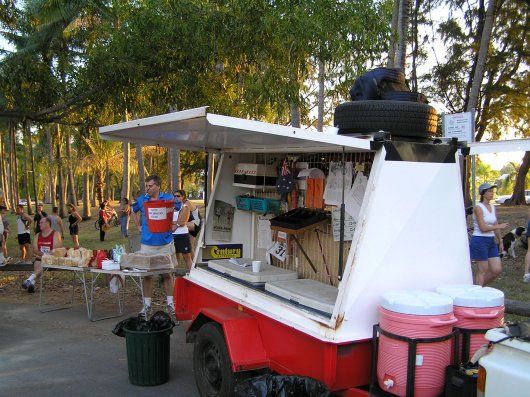
The club trailer carries equipment, notices, a barbecue and drinks.
Close to Christmas, Santa appears for a kids' Christmas run. Adult members usually enjoy a Christmas party in one of Darwin's restaurants or clubs. Photographs
10 km
10 km runs were a regular feature of the yearly calendar, especially at the Water Gardens where runners regularly did two laps of the 5 km course in the months leading up to the City to Surf and the Darwin marathon.
In 1982 the inaugural "City of Darwin 10 km Road Race" was held with trophies donated by the Lord Mayor, Cec Black. In the following year, the name was changed to the "Cec Black 10 km Road Race". For 10 years from 1983 it became an annual event on the flat roads around Yanyula Park. This was recognised as a very fast course where many runners did their best 10 km times. These days, 10 km road runs are from Vestey's beach, Farrar Road, and Amy Johnson Drive.
The Darwin City to Surf has been held every year since its inception on 8 June 1974. The course goes from The Esplanade in the city to the beach at Rapid Creek, or at times to the Nightcliff Pool. Over the years, the distance has varied from 12.7 to 13.7 km due to slight differences in the route and the location of the finish. Rod Lyons won the first City to Surf in 42 minutes 6 seconds, ahead of Jim Woodriffe and Dave Jones. Lois Bruce won the women's section.
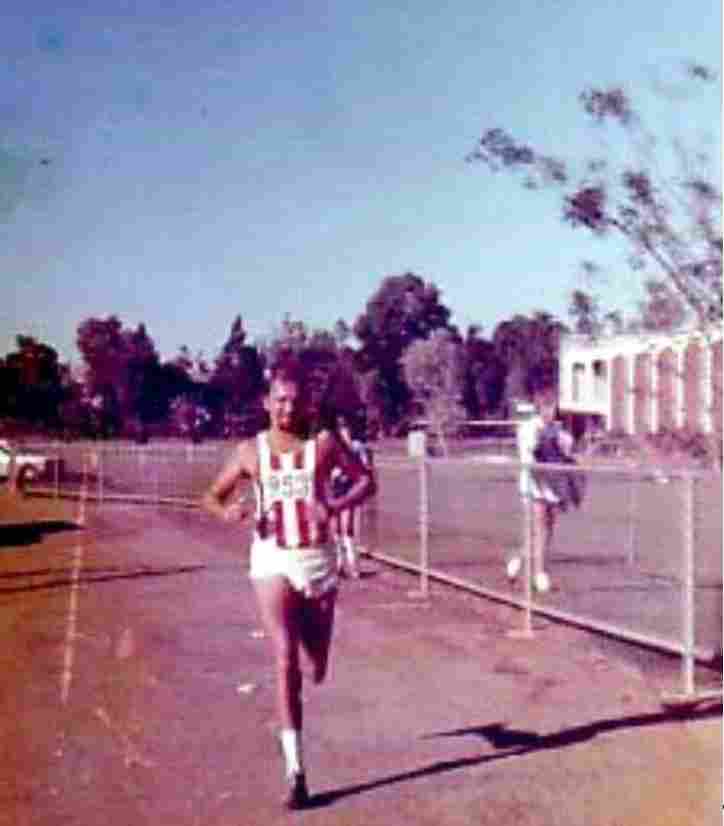
Klaus Roth cruises past Ludmilla Primary School in
the first City to Surf on 8 June 1974.
This run or walk has always been very popular for club members and for others that appear for the occasion. Numbers of runners increased from 150 in 1974 to over 600 in 1979 and 1980.
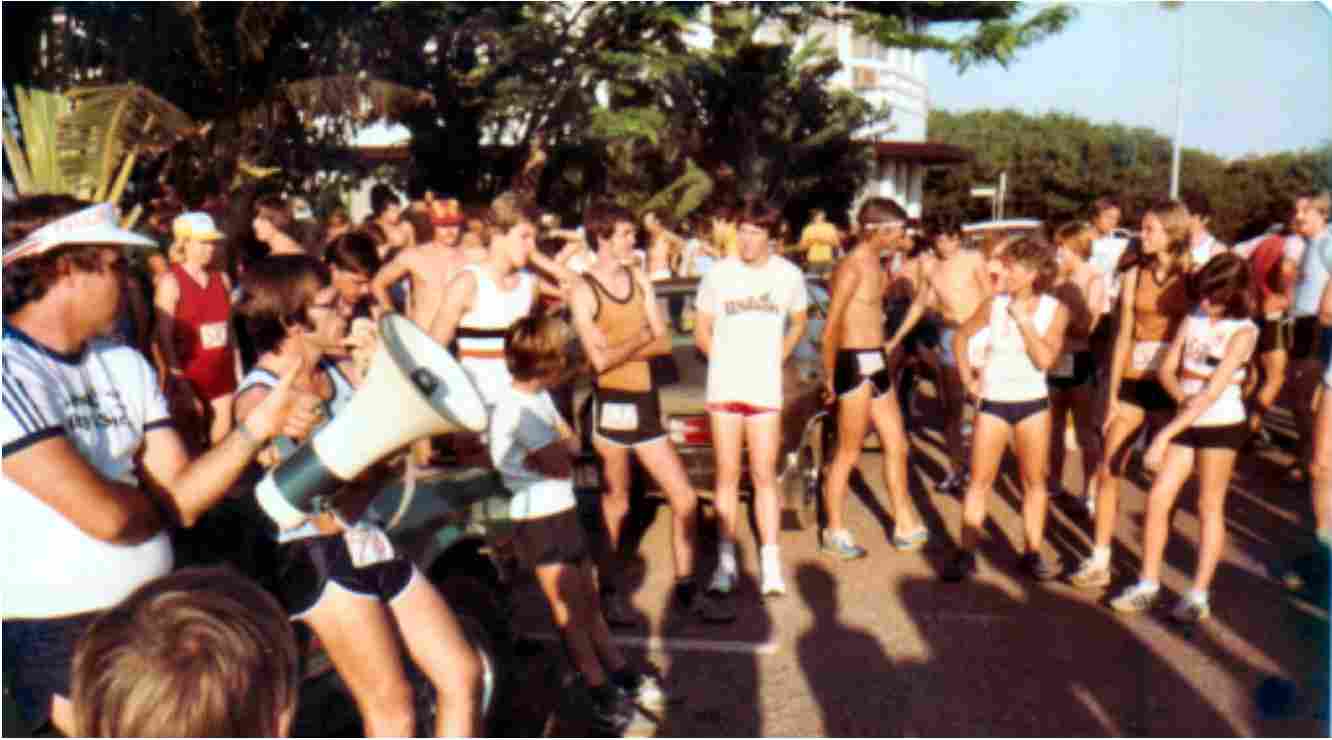 |
 |
||
In one year it was estimated to have 800 participants. This event requires a major effort to organise. Most of the run is on public roads, there is a need to provide for efficient registration at the start and finish, and there is a need for a supply of water along the way.
Darwin Runners & Walkers, NT Athletics, their predecessors and a multitude of sponsors have been involved in organising and supporting the City to Surf since its inception. One member, Steve Blake, has won the event 20 times, this being a record that is very hard to beat.
The first Darwin Marathon was run in the late 1960s. Most of the later marathons were organised by the Darwin Athletic Club although, in the 1980s, some long distance championships such as the NT cross-country championships and the NT Marathon Championships came under the auspices of the Northern Territory Athletics Association Incorporated (N.T.A.A.). The NT Marathon Championship was run as a separate event to the Darwin Marathon.
The Marathon Championships were held in May or July but, until 1984, the Darwin Marathon was run during a period of increasing humidity in September. Considering the climate, Darwin Marathon times for the 42.2 km journey were exceptionally good, front runners regularly finishing in the 2 hours 30 minutes to 2:50 bracket. In 1983, DAC members were selected to run in a Northern Territory team at the Australian Marathon in Sydney. Some ventured further afield to run in the Berlin, Boston and New York marathons. In 1985, the Darwin Marathon was moved to July to provide more comfortable and less stressful conditions for the run.
In the 1980s, the Darwin Marathon regularly attracted between 30 and 40 runners, but lack of interested runners in the late 90s resulted in its demise. The last Darwin Marathon was held on 11 July 1999 from Marrara Stadium, although half-marathons have remained very popular. The Darwin half-marathon is usually run in July. It is also an event in the biennial Arafura Games, which attract competitors from interstate and overseas.
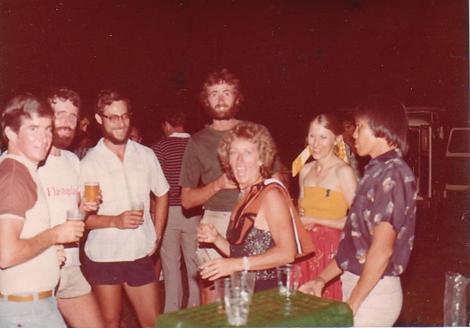
Darwin Marathon Presentation, 6 September 1981. Won by Adrian Wellington in 2 hrs 43 mins 18 secs.
L to R Ian Miller, Michael Seymour, Russel Willis, Peter Fogarty, Pat Sedman, unknown lady, David Fong.
The Darwin Cross-Country Championships and NT Championships have been held at various venues in Darwin including East Point, the lawns at Rapid Creek Water Gardens and at Holme's Jungle. From 1995, the Darwin Cross-Country Championships have been incorporated into the Fred's Pass Cross-Country Fun Run at Fred's Pass Reserve in the rural area.
The Australian Cross-Country Championships were held in Darwin on 9 July 1988. This gave Darwin people a chance to see Australia's best long distance runners in action on the oval and hills around Darwin High School. Club members assisted in organising the event as well as being marshals and umpires. The men's event (12 km) was won by two times winner of the Commonwealth Games Marathon, Robert de Castella (Victoria), in 37 minutes 35 seconds, while Jenny Lund of Queensland won the women's event (8km) in 28:53.
Cross-country events currently occupy about 30 percent of the year's calendar, the runs being held at a number of good sites around Darwin and in the rural area. The run from Dripstone Cliffs approximates the post-cyclone course in 1975, although the relatively recent paths that pass through the forest and cross the creek make for easier access.
Other cross-country courses are behind the old Waratah Oval, at the Botanic Gardens, Holmes Jungle, Berrimah Farm, the Surf Club, behind Royal Darwin Hospital, Lee Point, Lake Alexander and Fred's Pass Reserve.
In the 1980s the sport of triathlon was growing in popularity in Australia . The idea of holding a triathlon in Darwin was first formally discussed amongst a group of interested people at a meeting on 10 November 1981. These included members of Darwin Athletic Club. The meeting resulted in establishment of a Triathlon Organising Committee with Brenton Hancock of the Darwin YMCA as Race Director. In April 1982, a triathlon training guide was released entitled "Top End Runner". The inaugural Darwin Triathlon was held from Mindil Beach on 10 July 1982, being a 1 km swim in Fannie Bay, a 30 km cycle through the city to Berrimah and to Darwin Community College (now Charles Darwin University), followed by a 15 km run back to the Esplanade. Fifty four athletes started with 48 finishing.
From 1983 to 1986 the Darwin Athletic Club took responsibility for organising four Darwin triathlons and a number of mini-triathlons from 1985 to 1989. Biathlons were organised for off-season triathlon training. In 1987 the Darwin Triathlon came under the auspices of the Northern Territory Athletics Association.
The Darwin Triathlon Club formed towards the end of 1989. Some members of the Darwin Runners & Walkers Club also belong to the Darwin Triathlon Club (www.darwintriclub.com).
| The entry form for the second triathlon held at Mindil Beach on 9 July 1983. This was the first triathlon organised by the Dawin Athletic Club. |
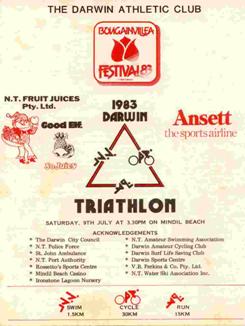 |
Over the past 30 to 40 years, many people have, and still do, make valuable contributions to development of Darwin Runners & Walkers Inc, either in the capacity of a committee member, by assisting in other ways, or by being members. Not all can be mentioned here, but the club acknowledges their valuable contributions.
Persons who provided historical information, either directly or through reference to old club correspondence, were Peter Garner, Brian Gleeson, Gordon Johnstone, Ian Miller, Klaus Roth, Helmut Schimmel, Peter Whelan and Russell Willis.
Feedback on the history of Darwin Runners & Walkers is welcome. Anyone who can provide written or photographic contributions is invited to contact the Webmaster.
Please send comments, feedback, bug reports and constructive criticism to the Webmaster, thank you.